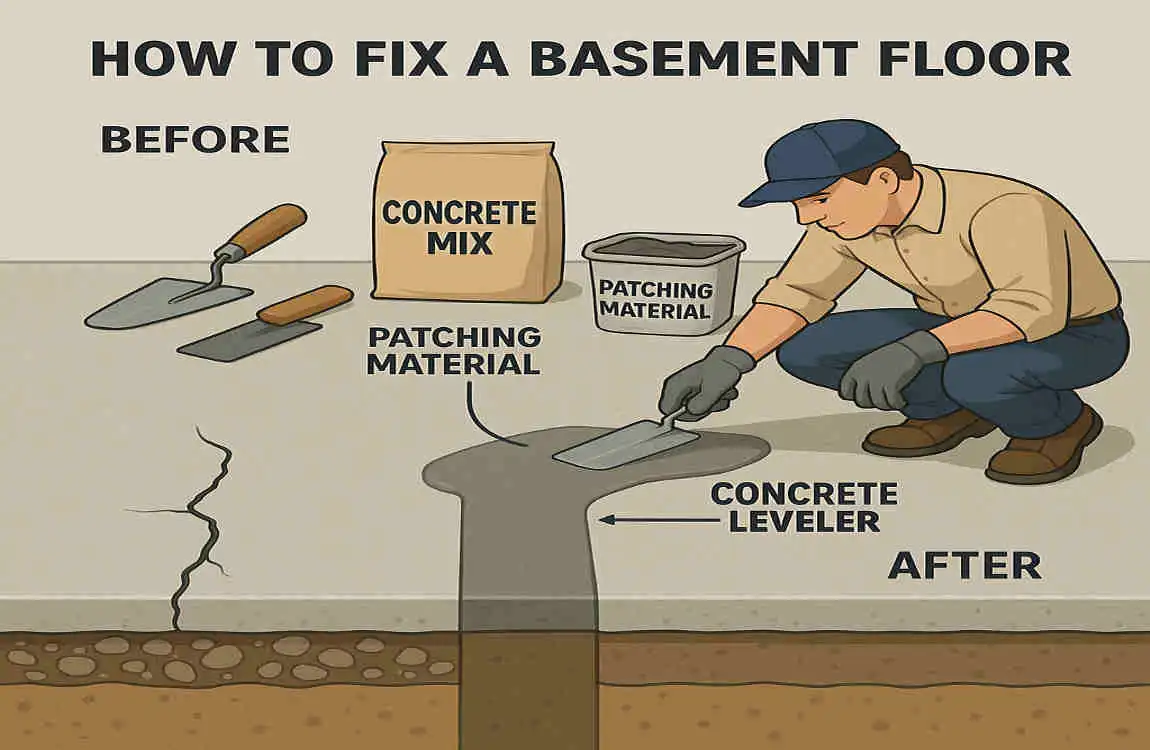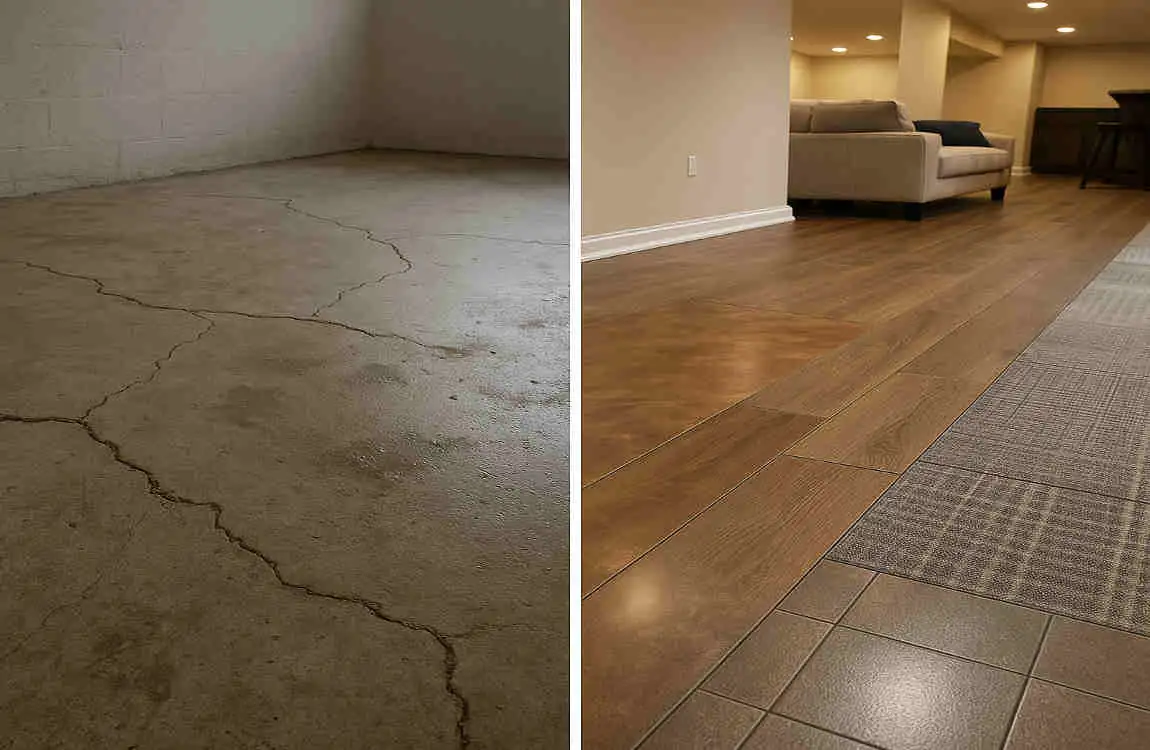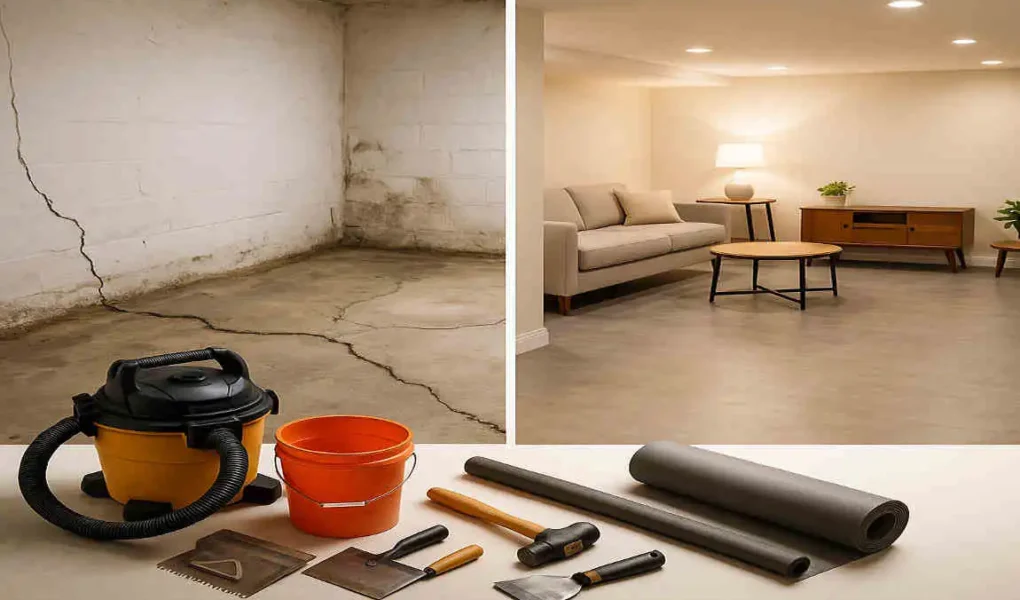Hey there, fellow homeowners! Are you tired of dealing with pesky basement floor problems? You’re not alone. Many homeowners encounter common issues, including cracks, uneven surfaces, and moisture damage. But don’t worry, we’ve got you covered.
Understanding Basement Floor Problems

Common Types of Basement Floor Problems
Let’s start by identifying the most common basement floor problems:
- Cracks and fractures: These can range from hairline cracks to large, structural issues.
- Sinking or uneven floors: This can be caused by soil settlement or foundation issues.
- Moisture and water damage: Water infiltration can lead to a host of problems.
- Mold and mildew presence: High moisture levels can create the perfect environment for mold growth.
- Surface deterioration: Chipping and spalling can occur due to poor construction or age.
Causes of These Problems
Understanding the root causes of these issues is crucial for effective repairs. Common causes include:
- Foundation issues: Settlement, shifting, or poor construction can lead to cracks and uneven floors.
- Water infiltration: Poor drainage, leaks, or high water tables can cause moisture damage and mold growth.
- Poor construction: Subpar materials or improper installation can lead to surface deterioration and other problems.
Assessing the Basement Floor Condition
How to Inspect and Evaluate Basement Floor Problems
Before you start any repairs, it’s essential to assess the condition of your basement floor. Here’s how:
- Visual inspection: Look for cracks, uneven areas, and signs of moisture damage.
- Moisture testing: Use a moisture meter to check for high humidity levels.
- Structural assessment: Check for any signs of foundation issues or structural damage.
Tools and Materials Needed for Inspection
To conduct a thorough inspection, you’ll need:
- Flashlight: To illuminate dark areas and spot cracks.
- Moisture meter: To measure humidity levels in the floor and air.
- Tape measure: To document the size and location of cracks and uneven areas.
- Camera: To take photos of the damage for future reference.
When to Call a Professional vs. DIY Assessment
While some minor issues can be assessed and fixed by homeowners, it’s crucial to know when to call in the pros. If you notice:
- Large or structural cracks
- Significant unevenness or sinking
- Severe moisture damage or mold growth
It’s best to consult with a professional to ensure the safety and integrity of your home.
How to Fix Basement Floor Cracks
Types of Cracks and Their Significance
Not all cracks are created equal. Here are the main types:
- Hairline cracks: These are typically less than 1/16 inch wide and are often cosmetic in nature.
- Large cracks: These can be up to 1/2 inch wide and may indicate more significant issues.
- Structural cracks: These are the most severe and can compromise the integrity of your home.
Step-by-Step Guide on Repairing Cracks
To fix basement floor cracks, follow these steps:
- Clean and prepare the crack: Remove any loose debris and dirt from the crack.
- Use epoxy or polyurethane injections: For hairline and large cracks, inject these materials to fill the gap.
- Patch with hydraulic cement: For larger cracks, use hydraulic cement to create a strong, waterproof seal.
Preventive Measures to Avoid Future Cracking
To minimize the risk of future cracking, consider:
- Maintaining proper drainage: Ensure water is directed away from your foundation.
- Keeping the basement dry: Use dehumidifiers and adequate ventilation to reduce moisture levels.
- Regular inspections: Check your basement floor regularly for signs of new cracks or damage.
Addressing Sinking or Uneven Basement Floors
Causes of Floor Sinking
Sinking or uneven basement floors can be caused by:
- Soil settlement: Over time, the soil beneath your foundation can settle, causing the floor to sink.
- Foundation issues: Poor construction or shifting can lead to uneven floors.
Solutions for Leveling the Floor
To address sinking or uneven floors, consider these solutions:
- Mudjacking, also known as slabjacking, involves injecting a mixture of water, soil, and cement beneath the floor to lift it back into place.
- Installing a new concrete overlay: For more severe cases, a new layer of concrete can be poured over the existing floor to provide a more durable surface.
- Using self-leveling compounds: These can be applied to minor uneven areas to create a smooth surface.
Safety Tips During Repair
When working on your basement floor, always:
- Wear protective gear: Use gloves, eye protection, and a dust mask to ensure your safety.
- Ventilate the area by opening windows and using fans to reduce dust and fumes.
- Follow manufacturer instructions: Read and follow all product labels and safety guidelines.
Moisture and Water Damage Solutions
Identifying Moisture Problems on Basement Floors
To spot moisture issues, look for:
- Damp areas: Check for visible water or wet spots on the floor.
- Musty odors: A musty smell can indicate high humidity levels.
- Peeling paint or wallpaper: This can be a sign of moisture damage behind the surface.
Waterproofing Basement Floors: Best Practices
To keep your basement dry, follow these best practices:
- Apply sealants and membranes: Use waterproof coatings on the floor and walls to prevent moisture penetration.
- Install vapor barriers and drainage systems: These can help direct water away from your foundation.
- Enhance basement ventilation by utilizing fans and dehumidifiers to lower humidity levels.
Importance of Fixing Leaks and Proper Grading Outside
To prevent future moisture issues, it’s crucial to:
- Fix any leaks: Repair any cracks or gaps in your foundation to stop water from entering.
- Ensure proper grading: Make sure the ground slopes away from your home to direct water away from the foundation.
Mold and Mildew Removal and Prevention
How Moisture Affects Basement Floors Leading to Mold
High moisture levels in your basement can create the perfect environment for mold and mildew growth. These fungi can:
- Damage your floor and walls: Mold can break down building materials over time.
- Cause health issues: Mold exposure can lead to respiratory problems and allergies.
Safe Ways to Clean and Remove Mold
To safely remove mold from your basement floor:
- Wear protective gear: Use gloves, a mask, and eye protection to avoid exposure.
- Mix a cleaning solution: Combine water and a mild detergent or vinegar to create a cleaning solution.
- Scrub the affected area: Use a stiff brush to remove the mold, then rinse with clean water.
- Dry the area thoroughly: Use fans and dehumidifiers to completely dry the floor.
Tips on Preventing Mold Through Floor Treatments and Maintenance
To prevent future mold growth, consider:
- Using mold-resistant flooring materials: Select materials such as epoxy or vinyl that are less susceptible to mold growth.
- Maintaining low humidity levels: Keep your basement dry by ensuring proper ventilation and using a dehumidifier.
- Regular cleaning and inspections: Keep your basement floor clean and inspect it regularly for signs of mold.
Upgrading Basement Floor Finishes for Style and Durability

Best Flooring Materials for Basements
When it comes to basement modern flooring, you have several options:
- Epoxy: Durable, waterproof, and available in a variety of colors and finishes.
- Tile: Stylish, easy to clean, and available in a wide range of designs.
- Vinyl: Affordable, water-resistant, and available in a wide range of styles.
- Stained concrete: Durable, low-maintenance, and can be customized with various colors and patterns.
Pros and Cons of Each Material in Terms of Durability and Style
Here’s a quick comparison of the pros and cons of each material:
Material Pros Cons
Epoxy: Durable, waterproof, customizable. Can be slippery, may require professional installation.
Tile Stylish, easy to clean, durable. It can be cold, and it may crack if not installed properly.
Vinyl is Affordable, water-resistant, and easy to install. Less durable than other options, may not be as stylish.
Stained concrete: Durable, low-maintenance, unique look. It can be cold, and it may require professional installation.
How to Install Stylish, Moisture-Resistant Finishes After Repairs
Once you’ve fixed any basement floor problems, you can install a stylish and durable finish:
- Prepare the surface: Clean and repair any remaining cracks or uneven areas.
- Apply a moisture barrier: Use a waterproof membrane to protect against future moisture issues.
- Install your chosen flooring: Follow the manufacturer’s installation instructions, whether it’s epoxy, tile, vinyl, or stained concrete.
- Seal and protect: Apply a sealant to protect your new floor and enhance its durability.
Incorporating Insulation and Underlays for Comfort
To make your basement floor more comfortable, consider:
- Insulating the floor: Use rigid foam insulation to reduce heat loss and maintain a warmer floor.
- Adding an underlay: Install a moisture-resistant underlay beneath your flooring to provide extra comfort and protection.
Tools and Materials Needed to Fix Basement Floors
List of Common Tools
To fix your basement floor, you’ll need:
- Concrete grinder: For smoothing rough surfaces and removing old finishes.
- Trowel: For applying patching materials and leveling compounds.
- Sealant applicators: For applying waterproof coatings and sealants.
- Drill and mixing paddle: For mixing patching materials and self-leveling compounds.
Recommended Materials
Some essential materials for basement floor repairs include:
- Epoxy: For filling cracks and creating a durable, waterproof finish.
- Hydraulic cement: For patching larger cracks and creating a strong, waterproof seal.
- Waterproofing products, such as sealants, membranes, and vapor barriers, protect against moisture.
Where to Purchase Quality Supplies for Basement Floor Repair
You can find quality basement floor repair supplies at:
- Home improvement stores, such as Home Depot or Lowe’s.
- Specialty concrete suppliers: For more specialized products and materials.
- Online retailers, Such as Amazon or specialized home improvement websites.
DIY vs. Hiring a Professional for Basement Floor Repairs
When DIY Is Appropriate and When to Consider Hiring an Expert
DIY repairs may be suitable for:
- Minor cracks and uneven areas: If the damage is cosmetic and doesn’t affect the structure.
- Simple moisture issues: If the problem is caused by a minor leak or high humidity.
However, consider hiring a professional for:
- Large or structural cracks: These may require specialized equipment and expertise.
- Significant unevenness or sinking: A professional can assess the cause and provide the best solution.
- Severe moisture damage or mold growth: A pro can ensure the problem is addressed safely and effectively.
Cost Estimates for Different Types of Repairs
The cost of basement floor repairs can vary widely depending on the extent of the damage and the chosen solution. Here are some rough estimates:
- Minor crack repairs: $100-$500
- Leveling an uneven floor: $500-$2,000
- Waterproofing and moisture control: $1,000-$5,000
- Professional mold remediation: $1,500-$6,000
What to Expect from Professional Basement Floor Contractors
When hiring a professional, expect:
- A thorough assessment: They’ll inspect the damage and provide a detailed plan for repairs.
- Clear communication: They’ll keep you informed throughout the process and answer any questions you have.
- Quality artistry: They’ll use the right materials and techniques to ensure a durable, long-lasting repair.
- Warranty and Guarantees: Many professionals offer warranties on their work, providing you with peace of mind.
Maintenance Tips to Keep Basement Floors in Top Shape
Routine Inspection and Minor Repairs
To keep your basement floor in great condition, make sure to:
- Inspect regularly: Check for new cracks, uneven areas, or signs of moisture damage.
- Address minor issues promptly: Resolve small problems before they escalate into major ones.
Proper Cleaning Methods for Basement Floors
To keep your basement floor clean and well-maintained:
- Sweep or vacuum regularly to remove dirt and debris, preventing scratches and wear.
- Mop with a mild detergent: Use a gentle cleaner to keep the floor looking its best.
- Avoid harsh chemicals: Refrain from using strong acids or abrasive cleaners that can damage the floor.
Monitoring Humidity Levels and Using Dehumidifiers
To prevent moisture issues and mold growth:
- Use a hygrometer to monitor the humidity levels in your basement, ensuring they remain below 50%.
- Run a dehumidifier: If humidity levels are high, use a dehumidifier to remove excess moisture from the air.
- Ventilate the space by opening windows and using fans to improve air circulation and reduce humidity.




